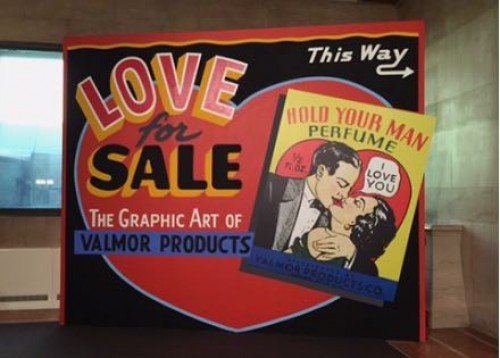Branding Chicago
The Art and Design of Promoting South Side Products
By: Nancy Bishop - Jun 10, 2015
Brand identity is a modern concept, or so it’s said. Companies, profit and nonprofit, and political campaigns devote extravagant amounts of time, money and energy to position themselves consistently—verbally and visually—with their priority audiences.
But almost a century ago, a small but creative company on the south side of Chicago developed its own distinctive brand and visual identity for an array of products designed to help its customers find beauty romance.Valmor Products’ advertising and packaging is the subject of a funny, provocative and eye-opening exhibit at the Chicago Cultural Center. Love for Sale: The Graphic Art of Valmor Products runs until August 2 in the 4th floor north exhibit hall, just across from the not-to-be-missed exhibit of the paintings of Archibald Motley: Jazz Age Modernist. See my Motley review for details. (All photos by Nancy Bishop.)
Valmor operated on the near south side (as the location image shows, near the intersection of Cermak Road and Indiana Avenue) from the 1920s through the 1980s. Their products were perfumes, hair pomades and straighteners, incense and a great variety of other products designed to help the individual (male or female) attract and please the opposite sex. Some of the products claimed to have mystical or magical powers.
The Cultural Center’s comprehensive exhibit is the first to show Valmor’s remarkable works of graphic design—product labels, packaging and advertising. Some of the labels were no bigger than a postage stamp, as you can see from the photo of the spilling bin of packages. (Other vintage bottles and containers are also on display.) Those tiny labels were enlarged to poster-size using modern imaging technology. The result is an exuberant display of social and cultural history as well as graphic design.
Charles Dawson, Valmor’s first designer, was a distinguished artist. His life and career are described here by the American Institute of Graphic Arts (AIGA), the professional organization for design. Dawson’s unpublished autobiography is in the DuSable Museum of African American history.
The Chicago Cultural Center, as I’ve noted before, is a Chicago treasure that many people aren’t aware of. It was opened as the city’s central library in 1897, designed by the Boston architectural firm, Shepley, Rutan and Coolidge. They created a number of monumental civic structures in the Romanesque style of Henry Hobson Richardson (best known here as architect of the John Glessner House). In 1977, the building was re-created as a city cultural center. It offers many exhibits of artistic and architectural interest, concerts, films and other performing arts events–and admission is always free.
The Washington Street side has a grand Carrara marble staircase leading to Preston Bradley Hall with its beautifully restored 38-foot Tiffany glass dome. The hall was the library’s main circulation room, which is why the mosaics that line the walls display the names of authors and philosophers. (View the restoration story in the video above.) If you enter on the Randolph Street side, you’ll find a large area with tables and seating, where you can meet with a friend or client, read or do a little work. But be sure to walk up (or take the elevator) to the fourth floor, where you’ll find both the Motley and Valmor exhibits.

